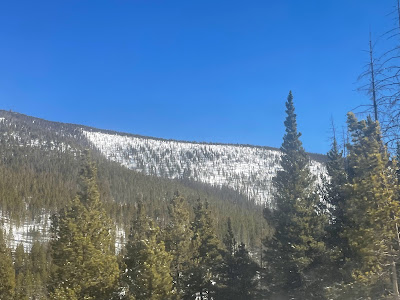The Marshall Fire that swept through Boulder County on December 30th, 2021 was pretty unexpected. The Cameron Peak Fire and Calwood Fires that affected Boulder and Larimer counties, were unexpected, but more typical for the forests around Colorado. Recently, I read an article recently that snow free winters were coming to Colorado before 2100. In other words, Colorado was going to be closer to New Mexico and Arizona in terms of weather. At the same time, the Colorado River basin is experiencing drought, and that affects a huge amount of agriculture and cities starting in western Colorado and all the way to California.
Both issues, drought and fires are related and have some similar actions that can mitigate their damage. A decade ago beetles killed millions of trees in Colorado and across the mountain west and into Canada, and they all have a similar mitigating factor, thinning out the forests. It's not complicated, and it's not necessarily easy, but it's an excellent solution.
A crowded forest does a few things:
- A dense forest soaks up all of the water that falls as rain and snow, leaving none to travel down to streams and rivers.
- A dense forest grows rapidly in the weeks after heavy rain, and dries out faster in weeks of no rain, leading to being very dry and more likely to burn when exposed to fire. In other words, the forest grows rapidly in May and June, dries out in July and August, and burns in September and October.
- A dense forest is more likely to spread bark pine beetles, and kill more trees.
- A dense forest constrains trees from flourishing because there is more competition for sunlight and water.
- It's really hard to ski through a dense forest.
- When a dense forest is wet it does product more oxygen and absorb up more carbon dioxide than a sparse forest, but that is largely wiped out when it burns, and the fact that the trees are competing for water and sunlight means that a forest with 20% of the trees will make more than 20% of the oxygen.
 |
| Monarch Pass January 23, 2022 |
We can't eliminate droughts or forest fires. We have to figure out how to live with them. We need clean air, you can only go a few minutes without it, and forest fire emissions put a lot of unhealthy particulate matter into the air. Similarly, without water we humans can only last a few days. Thinning out our forests in the years to come is one method that can help both increase the water supply and reduce the intensity of forest fires. It's not the be all end all solution to drought or wildfires, and it's impact on climate change is beyond my understanding at this time, except that it takes decades for a completely burnt forest to return to it's previous state, which of course doesn't help absorb as much carbon dioxide much during those rebuilding years.
Of course, if we all use less resources that will help reduce our impact, and there are other options to reduce the impacts of droughts and fires that professionals are working on, and the way knowledge goes I could be proven wrong tomorrow, yet it's been 20 years since I first learned about overcrowded forests and unfortunately the problem only seems to have gotten worse in those two decades.

No comments:
Post a Comment
Note: Only a member of this blog may post a comment.